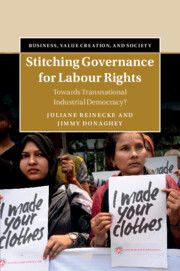Book contents
- Stitching Governance for Labour Rights
- Business, Value Creation, and Society
- Stitching Governance for Labour Rights
- Copyright page
- Contents
- Figures and Tables
- Foreword
- Foreword
- Acknowledgements
- Abbreviations
- 1 Introduction
- 2 The Democratic Deficit of Global Supply Chains
- 3 Democratic Representation
- 4 After Rana Plaza
- 5 Representative Alliances in the Creation of the Bangladesh Accord
- 6 Creating Representation through Industrial Democracy versus CSR
- 7 When Transnational Governance Meets National Actors
- 8 Building Representative Structures at the Workplace Level
- 9 Conclusion
- Book part
- References
- Index
- References
References
Published online by Cambridge University Press: 09 March 2023
- Stitching Governance for Labour Rights
- Business, Value Creation, and Society
- Stitching Governance for Labour Rights
- Copyright page
- Contents
- Figures and Tables
- Foreword
- Foreword
- Acknowledgements
- Abbreviations
- 1 Introduction
- 2 The Democratic Deficit of Global Supply Chains
- 3 Democratic Representation
- 4 After Rana Plaza
- 5 Representative Alliances in the Creation of the Bangladesh Accord
- 6 Creating Representation through Industrial Democracy versus CSR
- 7 When Transnational Governance Meets National Actors
- 8 Building Representative Structures at the Workplace Level
- 9 Conclusion
- Book part
- References
- Index
- References
Summary

- Type
- Chapter
- Information
- Stitching Governance for Labour RightsTowards Transnational Industrial Democracy?, pp. 230 - 250Publisher: Cambridge University PressPrint publication year: 2023

